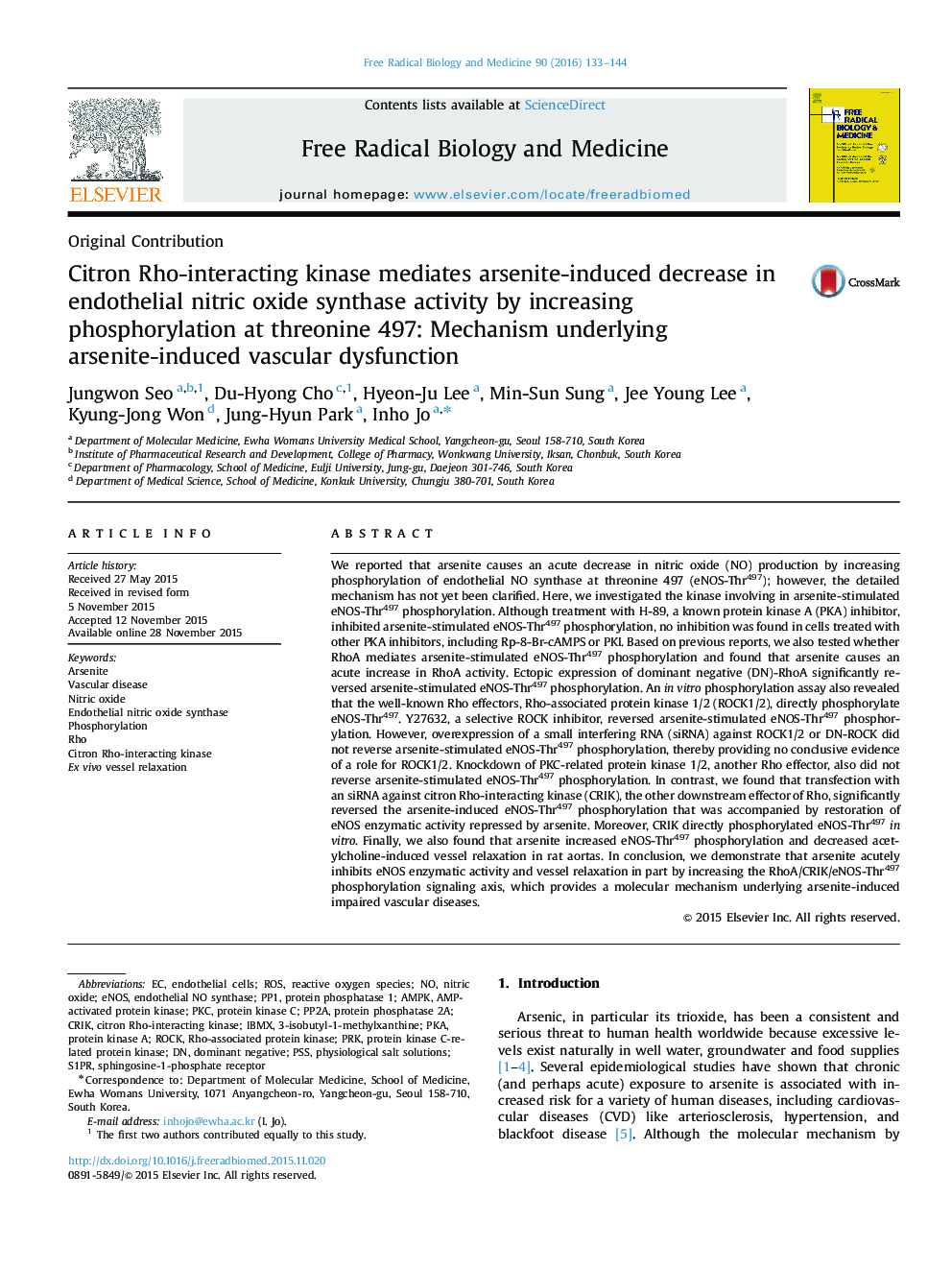| Article ID | Journal | Published Year | Pages | File Type |
|---|---|---|---|---|
| 8268201 | Free Radical Biology and Medicine | 2016 | 12 Pages |
Abstract
We reported that arsenite causes an acute decrease in nitric oxide (NO) production by increasing phosphorylation of endothelial NO synthase at threonine 497 (eNOS-Thr497); however, the detailed mechanism has not yet been clarified. Here, we investigated the kinase involving in arsenite-stimulated eNOS-Thr497 phosphorylation. Although treatment with H-89, a known protein kinase A (PKA) inhibitor, inhibited arsenite-stimulated eNOS-Thr497 phosphorylation, no inhibition was found in cells treated with other PKA inhibitors, including Rp-8-Br-cAMPS or PKI. Based on previous reports, we also tested whether RhoA mediates arsenite-stimulated eNOS-Thr497 phosphorylation and found that arsenite causes an acute increase in RhoA activity. Ectopic expression of dominant negative (DN)-RhoA significantly reversed arsenite-stimulated eNOS-Thr497 phosphorylation. An in vitro phosphorylation assay also revealed that the well-known Rho effectors, Rho-associated protein kinase 1/2 (ROCK1/2), directly phosphorylate eNOS-Thr497. Y27632, a selective ROCK inhibitor, reversed arsenite-stimulated eNOS-Thr497 phosphorylation. However, overexpression of a small interfering RNA (siRNA) against ROCK1/2 or DN-ROCK did not reverse arsenite-stimulated eNOS-Thr497 phosphorylation, thereby providing no conclusive evidence of a role for ROCK1/2. Knockdown of PKC-related protein kinase 1/2, another Rho effector, also did not reverse arsenite-stimulated eNOS-Thr497 phosphorylation. In contrast, we found that transfection with an siRNA against citron Rho-interacting kinase (CRIK), the other downstream effector of Rho, significantly reversed the arsenite-induced eNOS-Thr497 phosphorylation that was accompanied by restoration of eNOS enzymatic activity repressed by arsenite. Moreover, CRIK directly phosphorylated eNOS-Thr497in vitro. Finally, we also found that arsenite increased eNOS-Thr497 phosphorylation and decreased acetylcholine-induced vessel relaxation in rat aortas. In conclusion, we demonstrate that arsenite acutely inhibits eNOS enzymatic activity and vessel relaxation in part by increasing the RhoA/CRIK/eNOS-Thr497 phosphorylation signaling axis, which provides a molecular mechanism underlying arsenite-induced impaired vascular diseases.
Keywords
PP1S1PRpKaeNOSPRKPP2APKCPSSIBMXAMPK3-isobutyl-1-methylxanthineAMP-activated protein kinaseROSarseniteendothelial NO synthaseVascular diseaseRhoEndothelial cellsendothelial nitric oxide synthasedominant negativePhosphorylationNitric oxideprotein phosphatase 1protein phosphatase 2Aprotein kinase AProtein kinase CRho-associated protein kinaseReactive oxygen speciessphingosine-1-phosphate receptorRock
Related Topics
Life Sciences
Biochemistry, Genetics and Molecular Biology
Ageing
Authors
Jungwon Seo, Du-Hyong Cho, Hyeon-Ju Lee, Min-Sun Sung, Jee Young Lee, Kyung-Jong Won, Jung-Hyun Park, Inho Jo,
